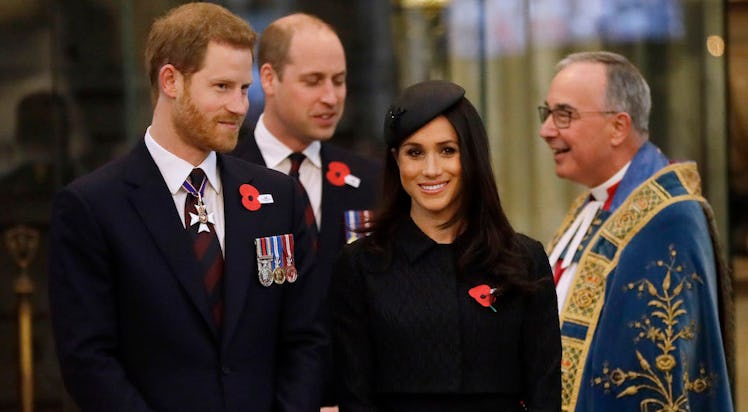
Here’s How Prince Harry & Meghan Markle Already Broke Tradition At The Royal Wedding
One of the reasons why the world is so fascinated by the wedding of Prince Harry and Meghan Markle is because the fiery young couple may actually stir some things up when it comes to the stuffy, centuries-old traditions of the British Royal Family. Of course, the couple did not ruffle too many feathers at their wedding, staying true to pretty much all of the royal traditions expected of their nuptials, but they did add some of their personal flair to really make the ceremony their own. Prince Harry and Meghan Markle broke some wedding traditions at their royal wedding on Saturday, May 19, although you may not have even noticed!
It is actually British tradition that the groom doesn't wear a ring at the wedding ceremony, but on the morning of the royal wedding, it was reported that Prince Harry had a platinum wedding ring made for himself at the ceremony. Harper's Bazaar confirmed Prince Harry would be receiving a ring at the ceremony, breaking from family tradition (both his brother Prince William and his father Prince Charles opted to not wear wedding bands). Another break from tradition is that reportedly, Meghan Markle and Harry will include some American songs in the wedding ceremony, breaking from the all-British music tradition at past royal weddings.
One of the most notable breaks from tradition is how Meghan Markle will get from the church's entrance to the altar. Traditionally, the bride's father walks her down the aisle and gives her away at the end, but after Markle's father initially pulled out of the wedding earlier this week, Markle revealed that Prince Charles will walk her halfway down the aisle, and then she will continue down the second half of the aisle alone.
Another break from tradition is that Meghan Markle is expected to speak at the ceremony, which actually goes against the British royal tradition. Apparently, this is also because of Markle's father's surprise non-appearance at the wedding. Normally, the father speaks for his daughter, but Markle is expected to speak for herself.
As you might expect, a wedding within the British Royal Family includes a laundry list of rules and traditions. While Meghan Markle and Prince Harry may have broken a few traditions, there are a whole bunch of traditions that they did follow to keep their nuptials a part of the long line of royal marriages before them.
1. The Carriage
With so many people interested in the event, it is traditional for the bride and groom of royal weddings to ride on a carriage and wave to their fans along the way. Meghan Markle and Prince Harry rode in the Ascot Landau carriage after saying their "I do's."
2. The Flowers
One of the most time-honored traditions in the British Royal Family is to include myrtle flowers in the bride's bouquet during royal weddings. The tradition stretches back to 1840, when it is believed that Queen Victoria included a sprig of myrtle in her bouquet when she married Prince Albert. Victoria then planted a garden of myrtle, and the flower was used in every royal bride's bouquet since.
3. Orange Blossoms
Another floral tradition that goes all the way back to Queen Victoria is the inclusion of orange blossoms in the royal bride's wedding outfit. Queen Victoria wore a wreath of orange blossoms on her head instead of her tiara, and since then, the tradition of orange blossoms continued. It was not always a wreath, however — modern royal brides incorporated orange blossoms in their dress or bouquet instead of on their heads.
4. The Ring
For the past century, it has been traditional for royal brides to wear a Welsh gold ring. This goes back to Queen Elizabeth's marriage in 1923, and was meant to proclaim rarity and uniqueness, since the gold mines in Wales scarcely did not dig up much gold, and mining for gold in the country no longer takes place today.
5. The Bouquet's Last Stop
The bridal bouquets from every royal wedding of the past century have all ended up at the same place after the ceremony: on the Tomb of the Unknown Warrior in Westminster Abbey. The tradition began when Queen Elizabeth placed her bouquet there in 1923, in remembrance of her brother who had died in World War I, and it continues to this day.